If we simply look at the final table of the 2021/22 season, Leeds’ Premier League existence were ‘hanging by a thread’. But if we dig deeper and analyze the season, we can say that based on the data, even a middle tier team can be in danger due to unfortunate circumstances.
Examining the PL rankings per round, they were not ranked higher than 15th during the season. However, relegation only came close in two periods: one during the change of manager in late February and the other in the final rounds of the season.
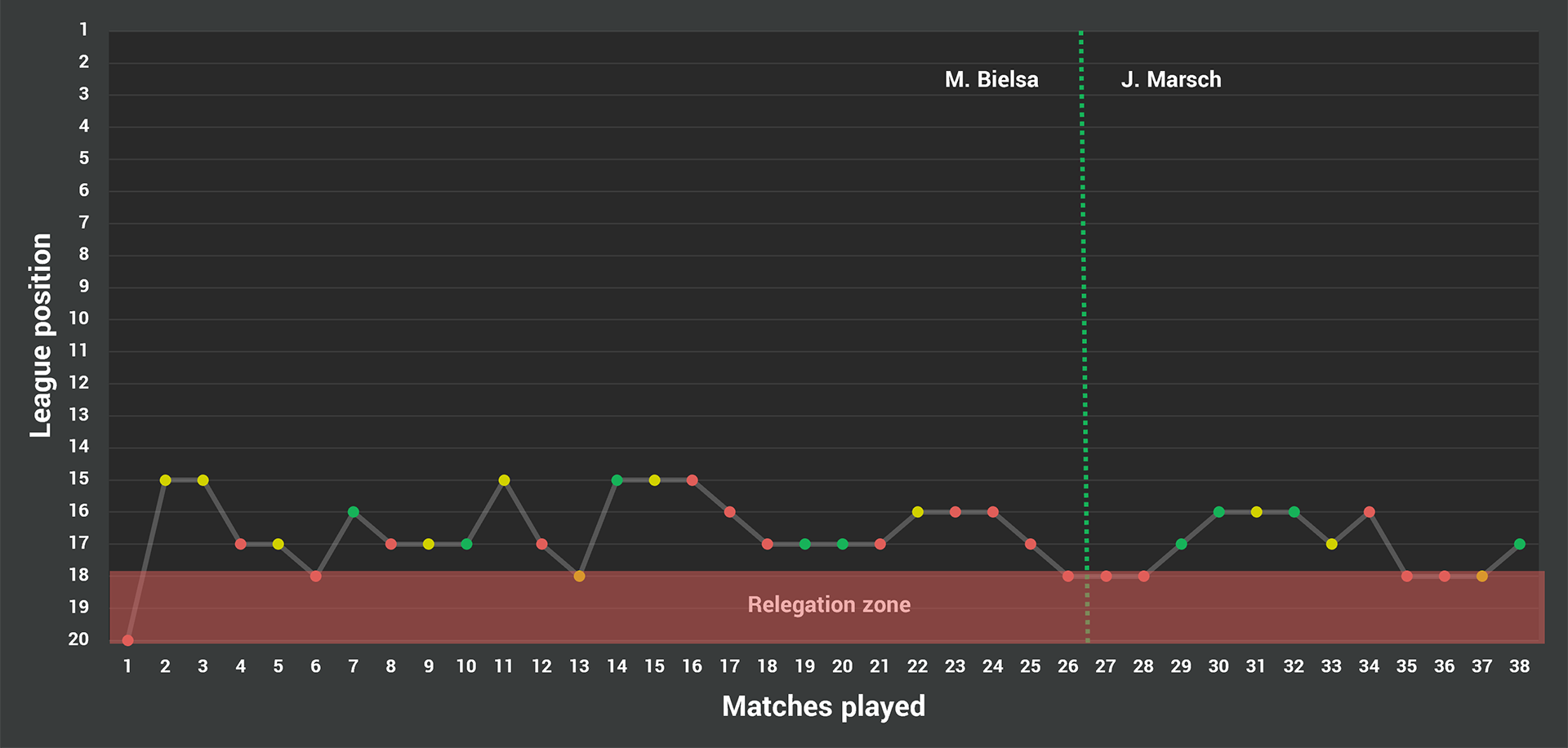
Here are the pure facts:
- Marcelo Bielsa sat on the bench in 26 matches, during which the team earned 23 points. It equals 0.88 points per match. He usually sent his team to the field in the 4-1-4-1 formation
- Jesse Marsch earned 15 points in 12 games in a typical 4-2-3-1 tactical formation, which is an average of 1.25 per game
The next chart on the left shows the trend of expected goals scored (xG) and conceded (xGA) over the season, calculated as a 5-match moving average. It can be seen that Leeds performed poorly in terms of the quality of both attacks and defenses. In the middle of the 2021/2022 season, a big setback is visible: the opponents were able to develop a lot more goalscoring opportunities (xGA around and above 2.0). Based on that, the change of coach came at the right time, and the team managed to reverse the trend: Bielsa’s xGA average of 1.98 was reduced by Marsch to 1.47. This is still a high number, but if we also add that xG increased from 1.42 to 1.51 over the last 12 rounds, then the xG-xGA difference has turned positive, albeit minimally.
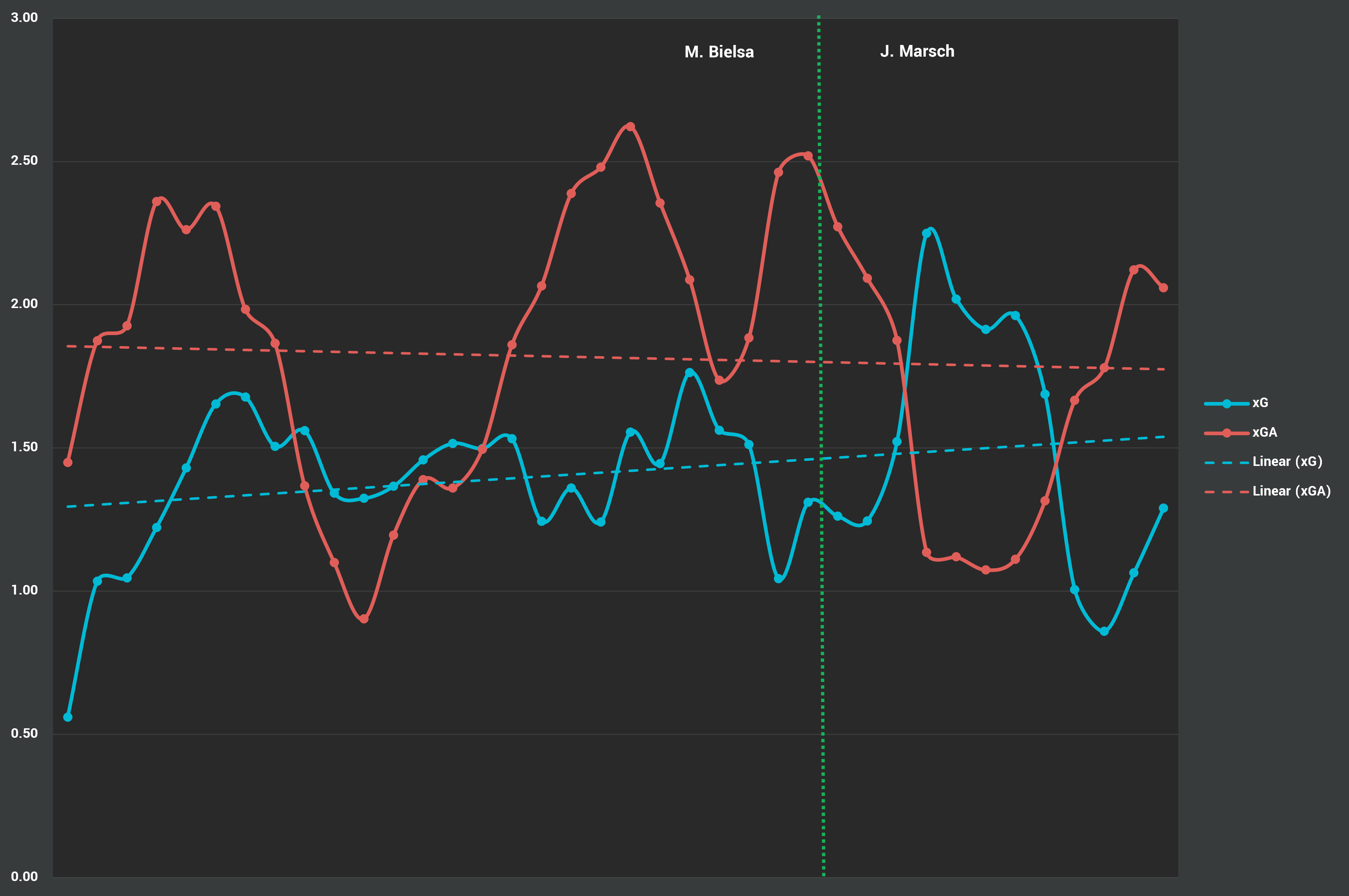
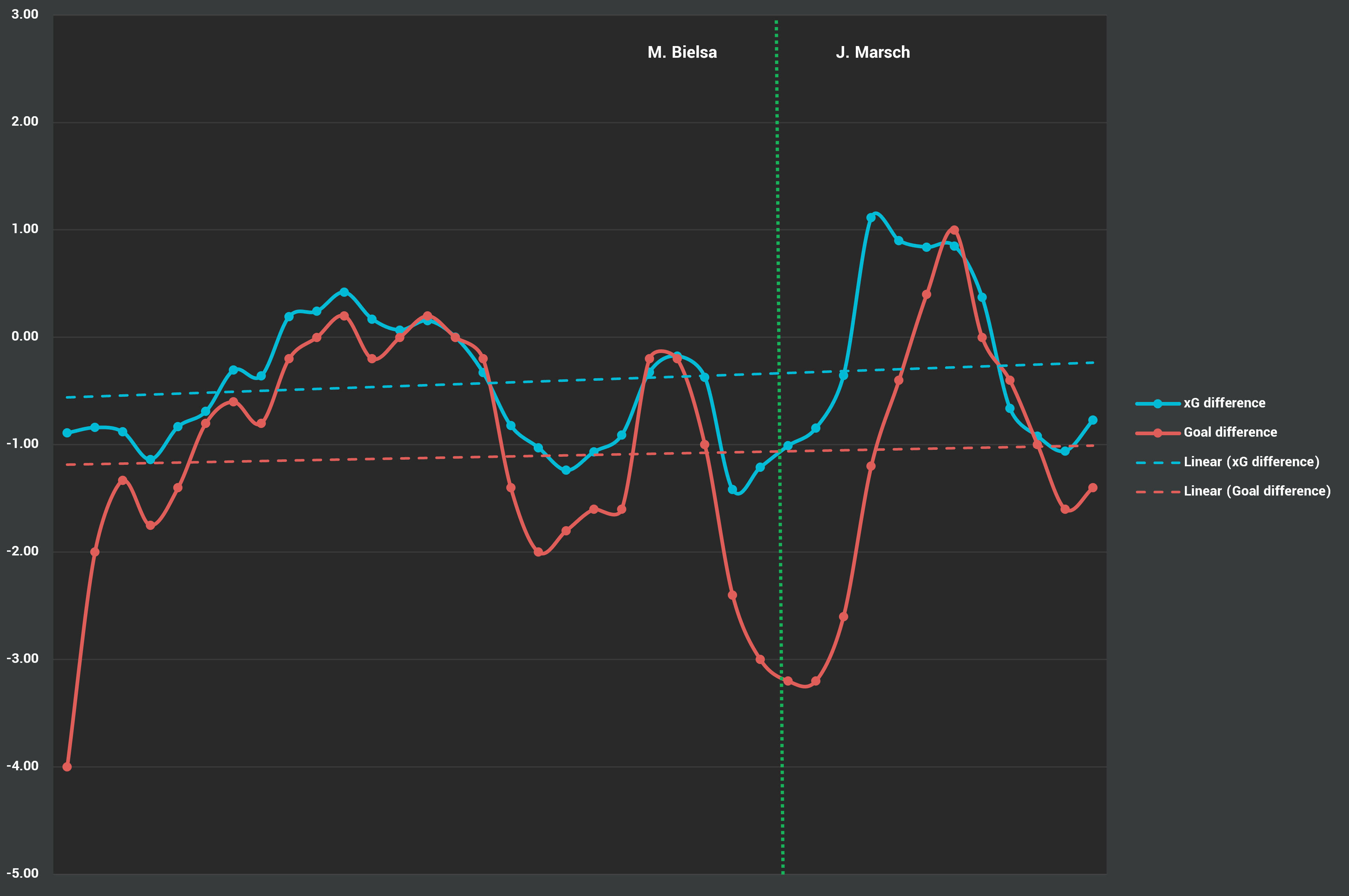
If we compare the xG difference (xG minus xGA) with the actual goal difference, then the middle of the season stands out again – the team ran into unexpected, big defeats. Under Bielsa, the team conceded 8.63 (!) more goals and scored 7.89 fewer goals than expected. For Marsch, the same indicators are 1.37 more goals conceded and 5.17 fewer scored goals. The numbers don’t lie, the defense has clearly improved under Marsch, but looking at the whole season, it’s still 10 more goals conceded and 13 fewer goals scored than expected.
Putting these numbers into context, let’s take a look at what this means compared to the rest of the Premier League. The result is devastating: the worst conversion of chances (based on actual goals minus xG) and the 2nd most goals conceded (79) in the league.
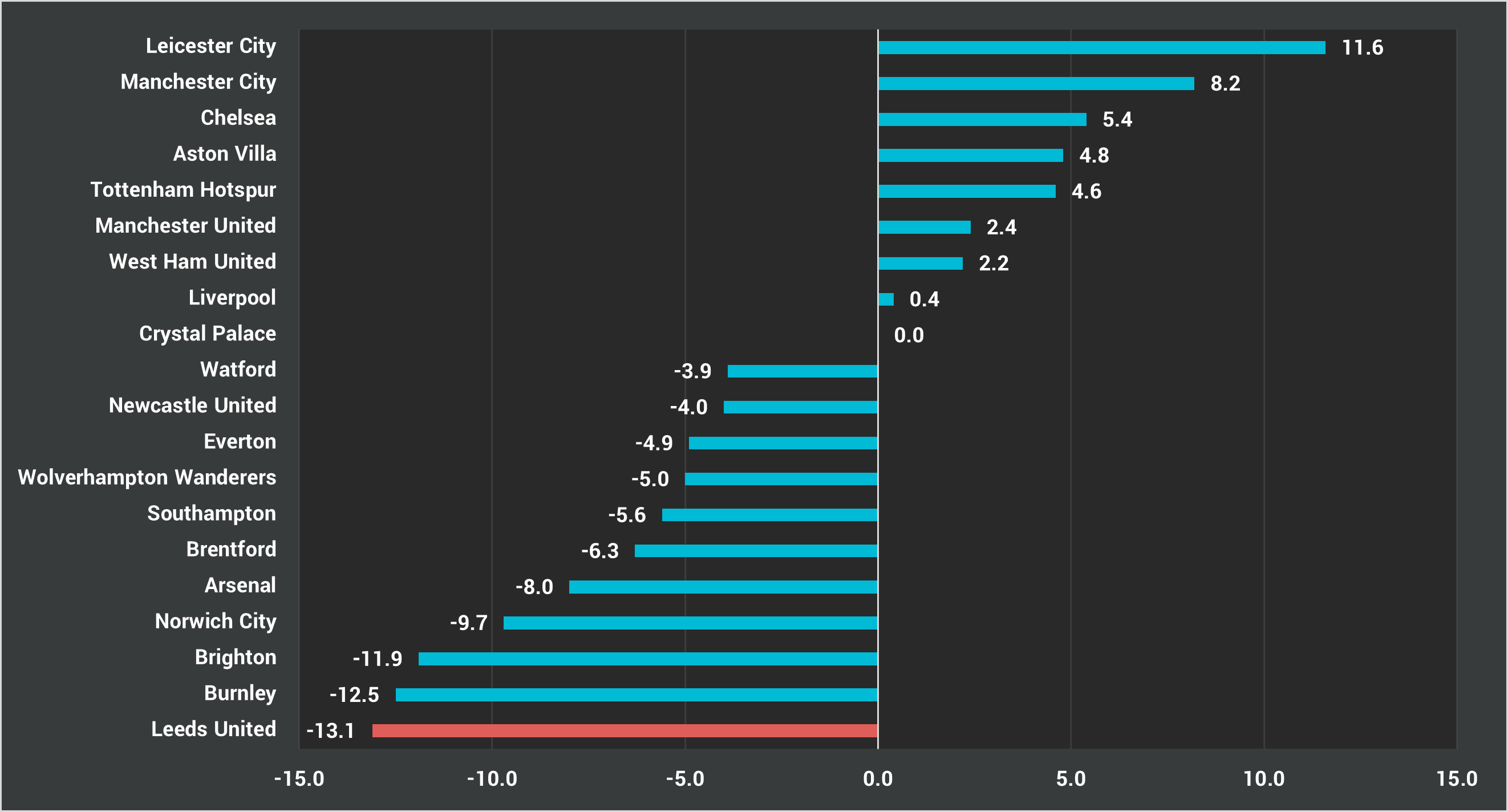
Next, let’s have a look at chance conversion: it is not enough to get into the right shooting positions, the quality of shot on goal also matters. This is adequately represented by the PSxG (Post-Shot Expected Goals) statistical indicator: it measures the probability of a goal scored after the shot was taken. For example, it makes a difference if a shot taken ends up in the center or the upper corner of the goal, or in the goalkeeper’s hands. Well, after Burnley and Brighton, Leeds players have made worst quality shots.
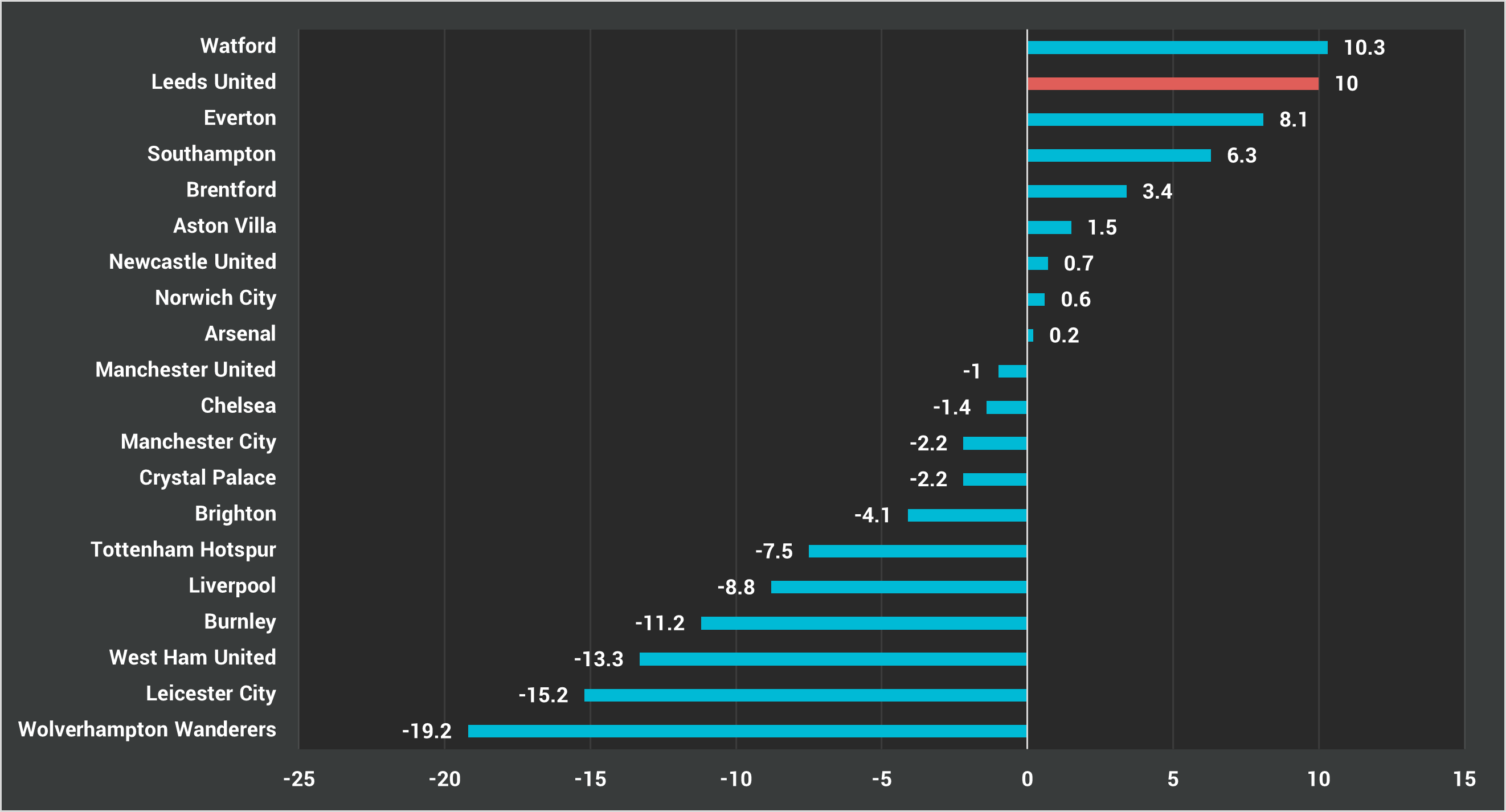
In case of expected goals conceded, as with xG, it is also worth evaluating the PSxG indicator, which specifically measures the performance of goalkeepers: how many goals did the goalkeeper save his team from or, conversely, how many goals was he responsible for? Based on the chart below we can say that Meslier did not excel during the season either.
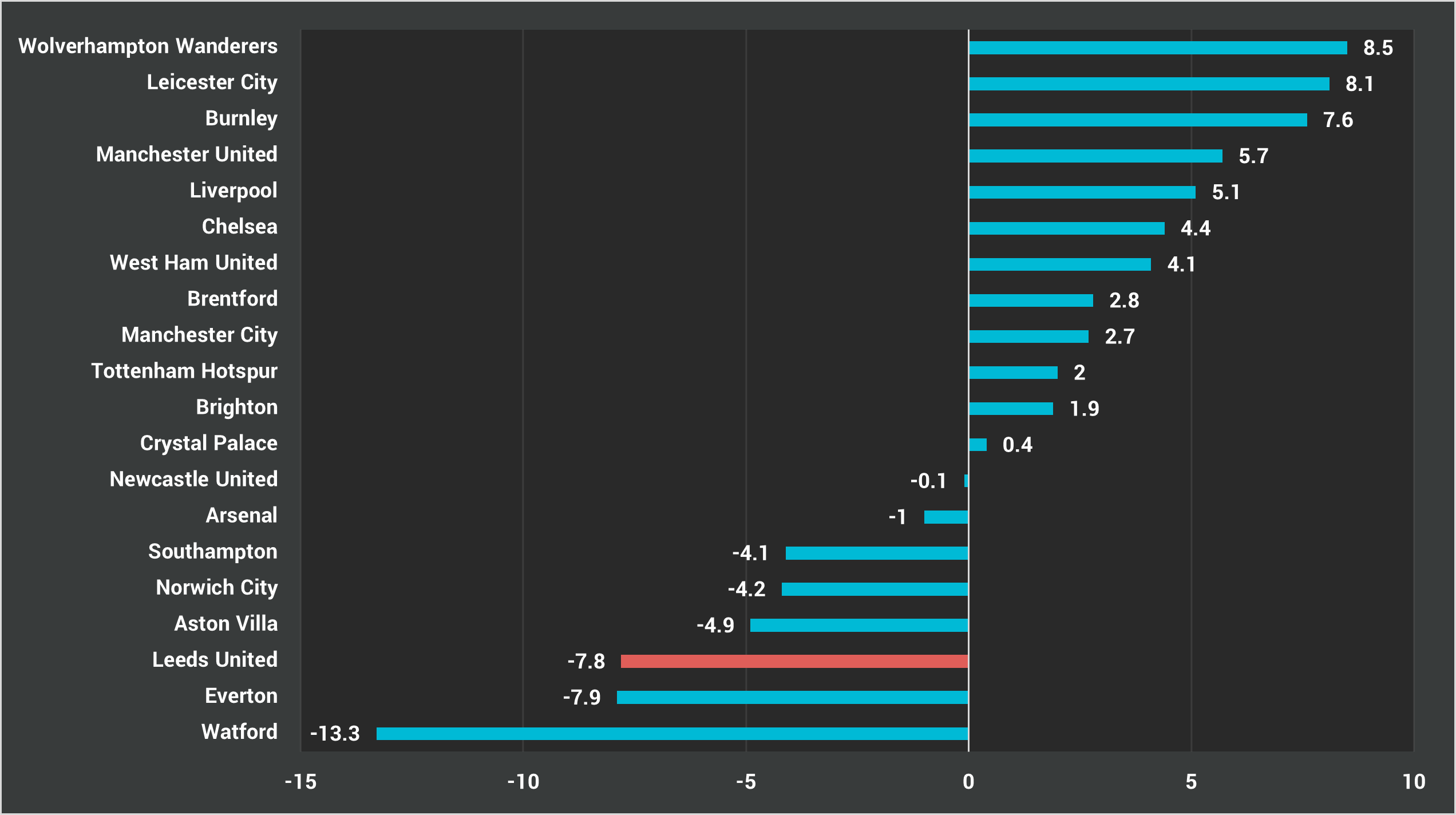
Bielsa’s last match on the bench in a way, was a reflection of the whole season: Leeds -Tottenham 0 4. We could say, it was an easy victory for the visiting team. But based on xG it was 2.54-1.66 for Leeds and anyone who saw the match could confirm that they deserved at least 1 point.
The home team was better in almost all (whether offensive or defensive) statistical indicators, but if they hadn’t known this before, this year Leeds learned that football is based on goals. Their chance conversion inefficiency contributed to their poor performance.
If you look at the pass network of the match against Tottenham at home, you can immediately see that the last defensive line of Leeds is located almost at the half way lines. This is a tactical element typical of the entire season, and indeed of the entire Bielsa era. Unfortunately, however - as it was seen in the match at the end of February - the high defensive line and pressing can backfire in certain matches, leading to easy, high-scoring victories for the opponents.
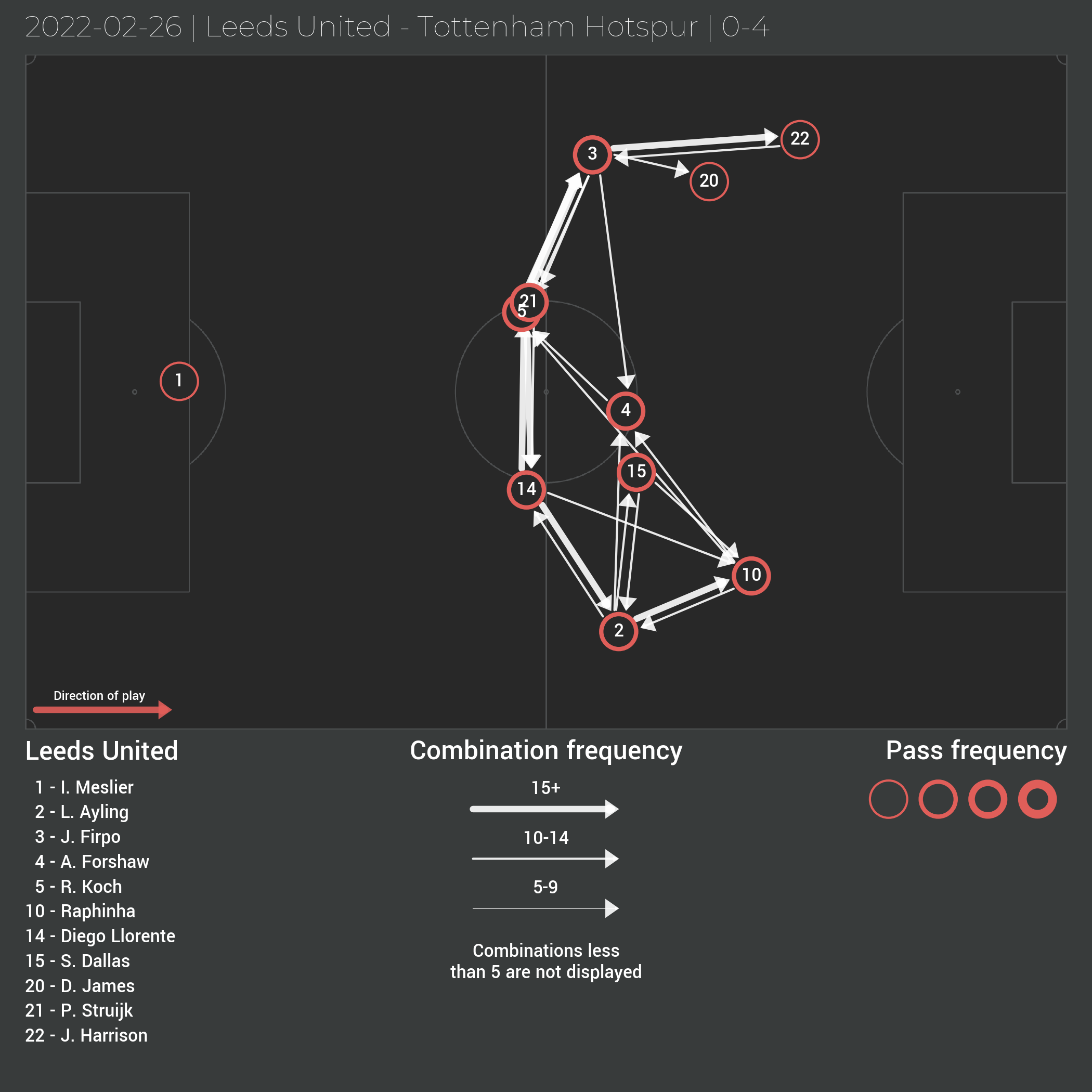
This tactic can best be characterized by the so-called PPDA (Passes Allowed Per Defensive Action) metric: it means how many passes on average a defensive team allows to the opponent in possession in the central and attacking thirds of the field until it is interrupted by a defensive action (be it a duel won or even a foul). The lower the PPDA number, the higher (and more intense) is the pressing of the team.
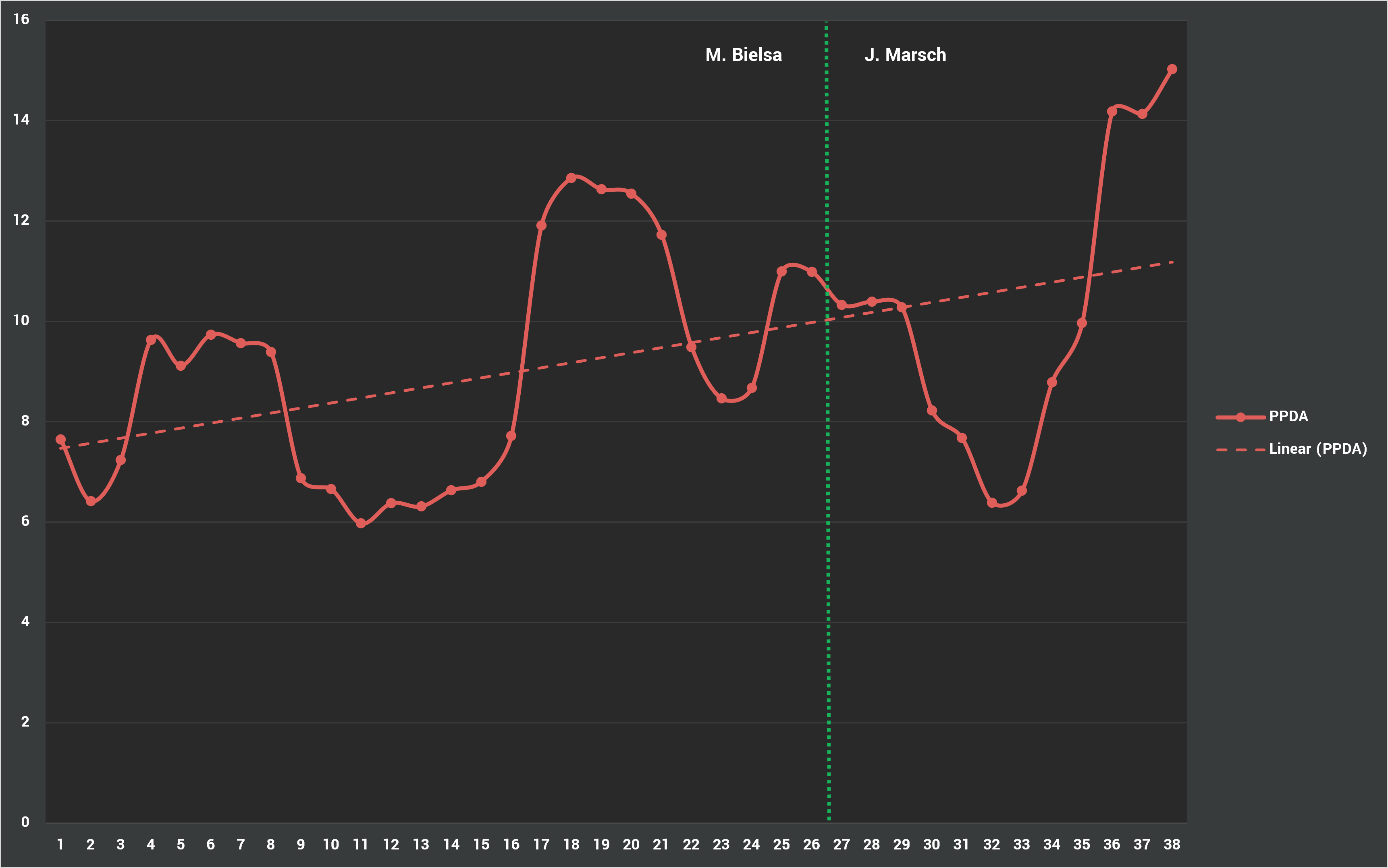
Only Liverpool (7.93), Manchester City (8.26) and Brighton (8.78) beat their season-level PPDA/90 of 8.87. If we look at the indicator before and after the manager change, it can be seen that Marsch has somewhat moderated their high pressure but this could also be due to the fact that the team defended deeper in these matches.
It should also be pointed out that they had the most defensive duels among the PL teams last season. Unsurprisingly, 4(!) of the league’s top 10 players with defensive duels came from Leeds: Firpo (1.), Phillips (3.), Dallas (4.) and Ayling (10.). Among all players, Cooper had the most ball recoveries (14.82 per 90).
At the same time, on the negative side, they made the most fouls (11.33 per match) and collected the most yellow cards (98 in this season, while City, who received the fewest, only 42).
Let’s also take a look at the results depending on PPDA. The figure below shows how many points the team collected compared to their PPDA numbers by match. We can see that defeat was almost inevitable whenever the value went above 10 (let’s consider the decisive match played in the last round as an exception that proves the rule). To make this pattern even more visible final results were marked with different colour: victory (green), draw (yellow) and defeat (red).
There are some interesting additional facts that can be read from the graph: they had 0 points against the final top 6. The goal ratio is also astonishing: in 12 matches, 8 goals scored and 47(!) goals conceded.
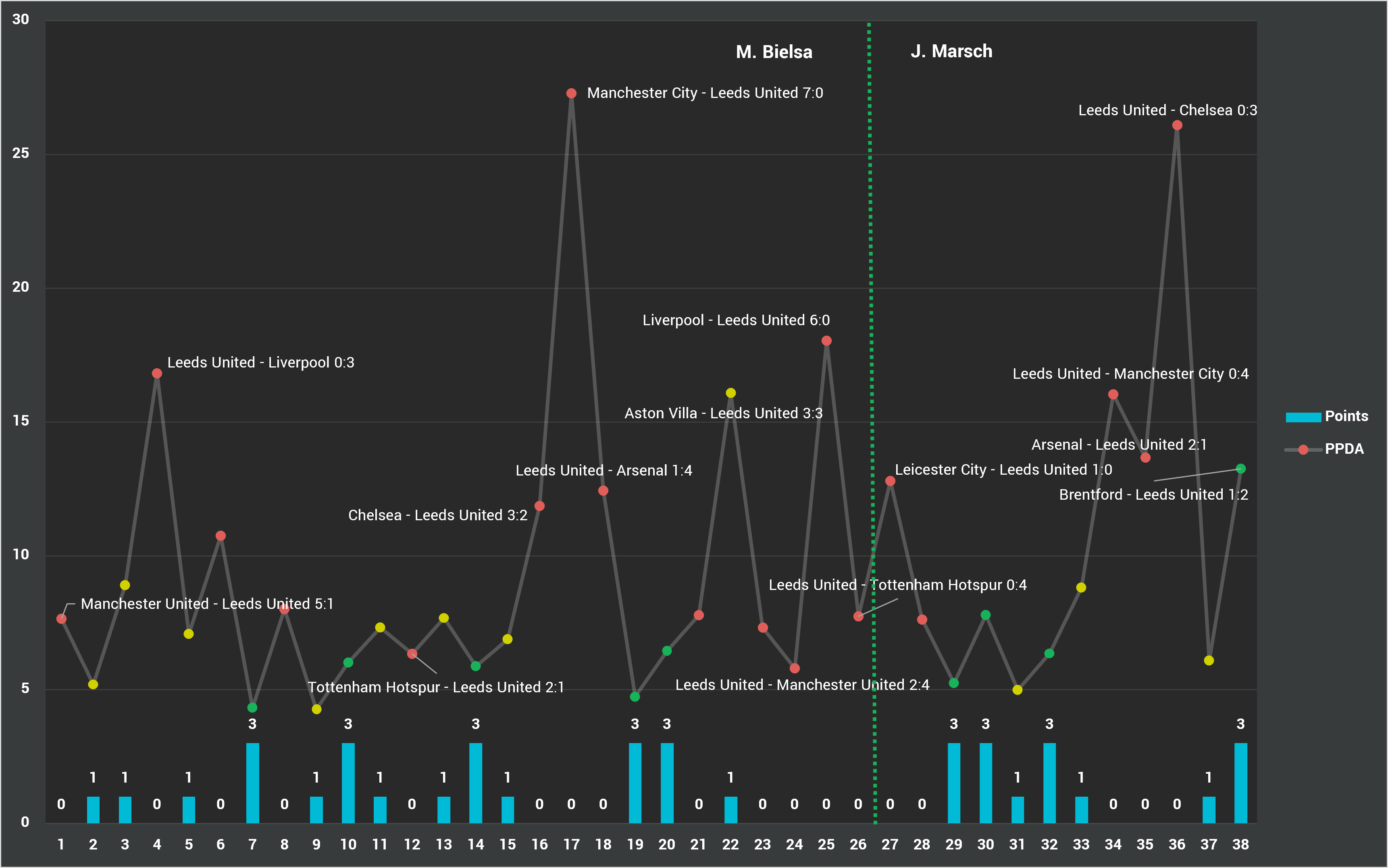
It is also important to note that this type of tactic based on aggressive pressing requires a lot of positioning, running and both physical and mental stamina from the team’s players. It is important that the staff has the suitable players available each week, also, how rotation is managed during the season to keep the players fresh. Let me highlight at this point that the wave of injuries hitting the team severely limited the available options for the manager. I will discuss the effect of injuries on the team in more detail later.
Some players who played a key role in the team’s defense were mentioned earlier. Let’s take a look at who had (or could have had) outstanding attacking performances during the season.
When assessing a team’s attacking play both goals and assists play an important role. Top scorers in the team were Raphinha (11 goals), Harrison (8), Rodrigo (6) and James (4). While James (4) and Raphinha (3) were prominent in terms of giving the final pass before the goals, followed by 5 players recording 2-2 assists each.
Next, let’s take a look at xG and xA (expected assists) numbers within the team. For xG the ranking is lead by Raphinha (10.08), followed by James (6.62), Rodrigo (5.47) and Harrison (4.95). Compared with the number of goals scored, it is immediately apparent that Harrison overshot and James undershot their xG. Looking at expected assists, Raphinha (7.49), Harrison (3.64), Rodrigo (3.16) are the top 3 players. Here, the difference between the actual assists and the expected ones is much bigger, and in the negative direction. James is the only exception, since he collected 4 assists from an xA of 2.30. The xA numbers actually also confirm that the team have created adequate chances, but they just failed to convert them into goals.

In the figure above, we see the xG and xA numbers calculated per match for the players in the squad with at least 600 minutes of playing time. This approach gives a more accurate picture as the aggregate sums of xG and xA are biased by playing time – players spending more time on the pitch have a better chance of producing higher xG and xA numbers. Players responsible for the goals: Bamford, Gelhardt, Raphinha, Roberts, James and Rodrigo. Assists were expected to come from Raphinha, Gelhardt, Harrison, Rodrigo and Roberts.
Among the previously known players there are some new ones: last season’s top scorer Bamford and two young forwards in Gelhardt and Roberts. Although they got fewer playing minutes (e.g. Bamford was injured almost the whole season), they still represented quality. On the other hand, it must be added that with their conversion rates, both Gelhardt and Roberts opened themselves up to criticism – based on their xG, they both should have scored 2 more goals.
Another useful indicator of assessing attacking play is xT (expected threat): it shows the extent to which a player’s actions on the field (e.g. passes, carries, dribbles, etc.) increase the chance of their team scoring a goal.

As the last chart shows, Ayling, Dallas and Raphinha are the order on the imaginary podium in creating danger per match. It is also clear which players created danger through their passing (Ayling, Phillips, Dallas and Firpo - playing in a defensive position) and which are the ones with carrying the ball (Harrison, Raphinha, James – offensive section).
In the following section let’s examine how the playing minutes of the Leeds players have evolved during the season and the extent to which the previously mentioned squad rotation was applied.

During the entire season, 29 players were involved and the squad was relatively balanced both in terms of age and playing minutes. The defense was mainly based on the more experienced players (Dallas, Ayling, Llorente, Cooper and Koch), but the youngsters (Struijk, Firpo) also have a lot of playing minutes.
If we take the wingers out of the group, the midfield seems to be the most unbalanced team unit. Klich and Forshaw are already over 30, Phillips is the only one who is in his peak age (between 24-29 years old). The Leeds United academy product Shackleton is someone for the future..
Among the attackers, Raphinha, Harrison and James were prominent in terms of minutes played. Other than them Rodrigo represents stability, while Gelhardt, Roberts and Greenwood are the up-and-coming youngsters who may gradually be assigned more and more responsibility. Last but not least, there is Bamford, whenever is on the field provides goalscoring threat, and someone we can expect goals from.
I deliberately left Bamford to the end, because one important factor was left out of the previous sections, which greatly influenced Leeds’ performance this year: injuries. The centre forward, who was also called up to the English national team after his successful league performances last year, was forced to miss almost the entire season due to injuries (he was only able to play an entire match in the first 5 rounds of the 2021/2022 season). Rodrigo was also absent from the offensive line for 4 games due to health problems, while Roberts was out for the last 11 matches.
Moving from front to midfield, Forshaw also suffered a serious knee injury before the final rounds, missing 7 games. The other biggest missing person of the season is certainly Phillips, who was not available for 15 matches between December 2021 and April 2022.
As for the defenders, only Diego Llorente has not been absent due to injury. However, Koch 16, Cooper 15, Ayling 9, Firpo 7, Struijk 5, and Dallas missed 4 matches due to injury. And this is a long list of key players, which had a clear adverse effect on the team’s performance.
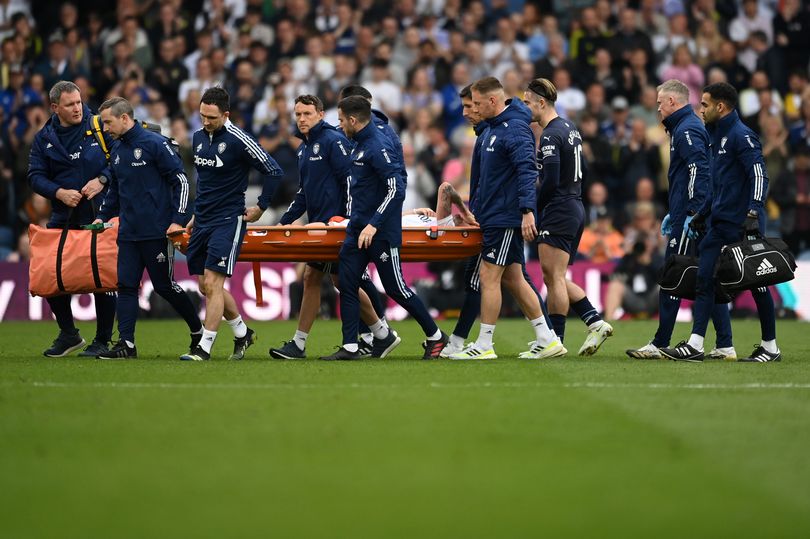
If we try to evaluate the season, the defense was stabilized very quickly by Marsch, who replaced Bielsa for the last third of the season. Furthermore, chance conversion improved minimally, and the opponents had fewer opportunities to score goals. Marsch has performed fine as a firefighter in that aspect, but in my opinion that’s due to Phillips and team captain Cooper coming back from their injuries. Bielsa faced a wave of injuries to such an extent that it cost him his job. In fact, the uncertainties arising from the defense decimated by injuries were mercilessly exploited by stronger opponents, and the attackers certainly want to forget this season’s conversion of chances as soon as possible.
If I want to highlight a positive, then despite the fact that they missed both Dallas, injured in the final rounds, and Ayling, suspended due to the red card, in the last match, fate gave back what it had taken away during the whole season. In the dramatic final game against Brentford, the winning goal came in the 94th minute with a two man advantage in the last 15 minutes, ensuring at least another season in the Premier League.
The question is, if there won’t be so many injuries and both the defense and the attackers perform closer to their expected numbers, will Leeds be able to finish in the middle of the table again? It is already apparent that the most effective player of the season, Raphinha, will most likely have to be replaced, as he wants to join a top team and the transfer of the stable English international Phillips to Manchester City is also a big loss. It seems that Marsch will be given time to work on deepening and strengthening the squad. There will certainly be no shortage of excitement at Elland Road in the 2022/2023 season either.
(Cover photo: www.tycsports.com )



